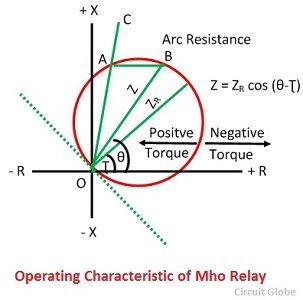A mho Relay is a high-speed relay and is also known as the admittance relay. In this relay operating torque is obtained by the volt-amperes element and the controlling element is developed due to the voltage element. It means a mho relay is a voltage controlled directional relay.
A mho relay using the induction cup structure is shown in the figure below. The operating torque is developed by the interaction of fluxes due to pole 2, 3, and 4 and the controlling torque is developed due to poles 1, 2 and 4.
 If the spring controlling effect is indicated by –K3, the torque equation becomes,
If the spring controlling effect is indicated by –K3, the torque equation becomes,
![]() Where Θ and τ are defined as positive when I lag behind V. At balance point, the net torque is zero, and hence the equation becomes
Where Θ and τ are defined as positive when I lag behind V. At balance point, the net torque is zero, and hence the equation becomes
![]()

 If the spring controlled effect is neglected i.e., k3 = 0.
If the spring controlled effect is neglected i.e., k3 = 0.
Operating Characteristic of Mho Relay
The operating characteristic of the mho relay is shown in the figure below. The diameter of the circle is practically independent of V and I, except at a very low magnitude of the voltage and current when the spring effect is considered, which causes the diameter to decrease. The diameter of the circle is expressed by the equation as ZR= K1 / K2 = ohmic setting of the relay
 The relay operates when the impedance seen by the relay within the circle. The operating characteristic showed that circle passes through the origin, which makes the relay naturally directional. The relay because of its naturally directional characteristic requires only one pair of contacts which makes it fast tripping for fault clearance and reduces the VA burdens on the current transformer.
The relay operates when the impedance seen by the relay within the circle. The operating characteristic showed that circle passes through the origin, which makes the relay naturally directional. The relay because of its naturally directional characteristic requires only one pair of contacts which makes it fast tripping for fault clearance and reduces the VA burdens on the current transformer.
The impedance angle of the protected line is normally 60º and 70º which is shown by line OC in the figure. The arc resistance R is represented by the length AB, which is horizontal to OC from the extremity of the chord Z. By making the τ equal to, or little less lagging than Θ, the circle is made to fit around the faulty area so that the relay is insensitive to power swings and therefore particularly applicable to the protection of long or heavily loaded lines.
For a given relay the τ is constant, and the admittance phasor Y will lie on the straight line. The characteristic of mho relays on the admittance diagram is, therefore, a straight line and is shown in the figure below.
 Mho relay is suitable for EHV/UHV heavily loaded transmission lines as its threshold characteristic in Z-plane is a circle passing through the origin, and its diameter is ZR. Because of this, the threshold characteristic is quite compact enclosing faulty area compactly and hence, there is lesser chance to operate during power swing and also it is directional.
Mho relay is suitable for EHV/UHV heavily loaded transmission lines as its threshold characteristic in Z-plane is a circle passing through the origin, and its diameter is ZR. Because of this, the threshold characteristic is quite compact enclosing faulty area compactly and hence, there is lesser chance to operate during power swing and also it is directional.

Awesome content